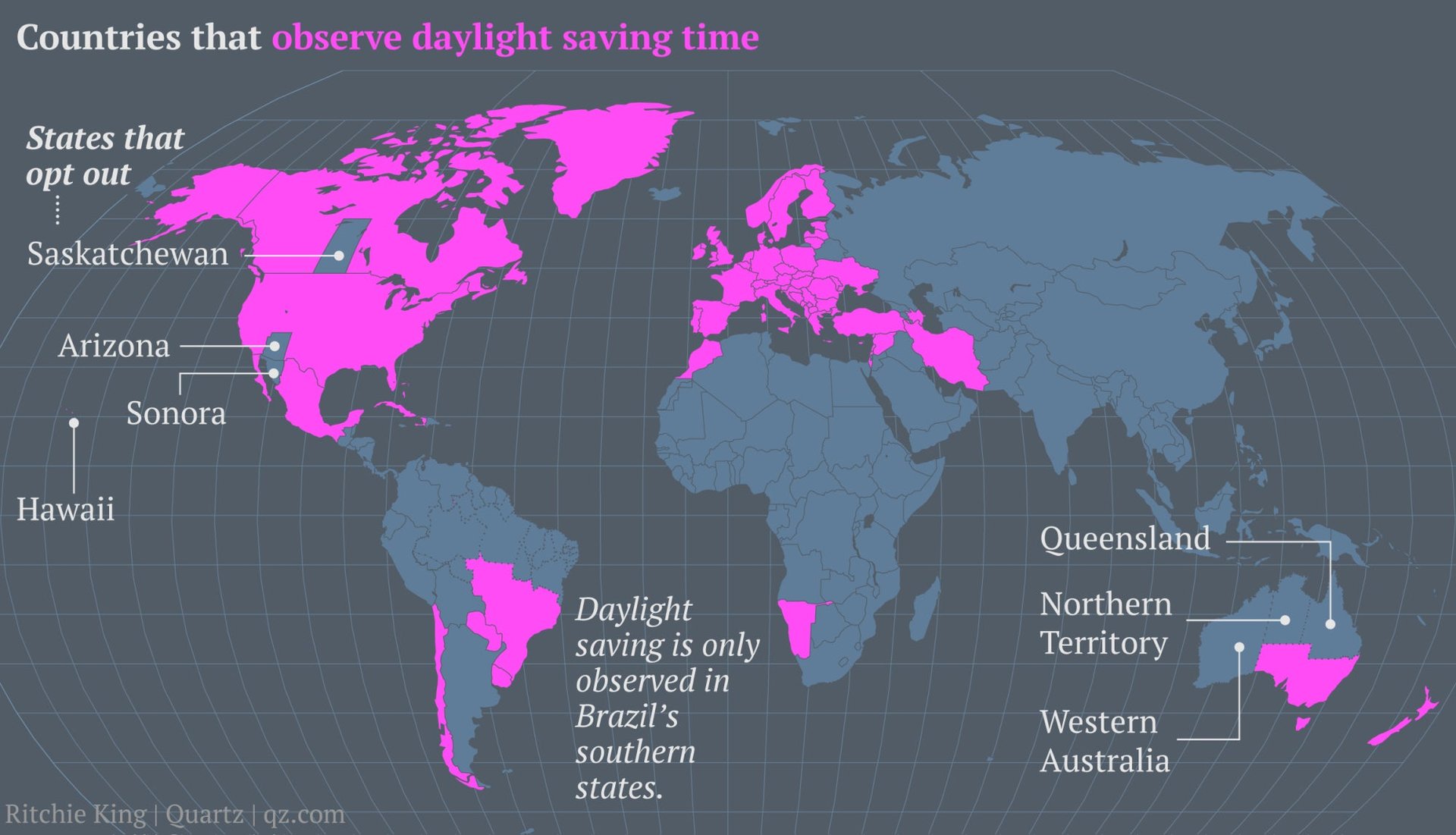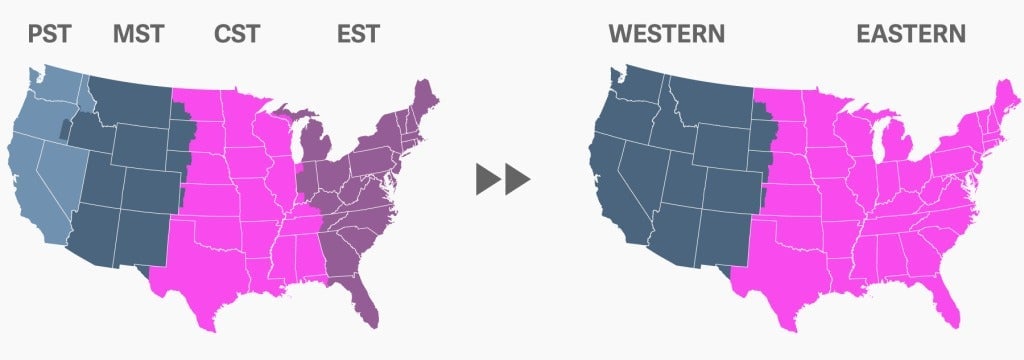America needs to have just two time zones and the world should follow suit
This Sunday the United States (except Hawaii, Arizona, and parts of Alaska), Canada (except Saskatchewan and small pockets in other territories), and parts of Mexico will start Daylight Saving Time again. Several Caribbean Islands (including Cuba) will also set their clocks forward. Many countries in Europe will set their clocks forward on March 29. Several countries in the Middle East also observe daylight savings, though most of them do so on different days of the week. How can we expect peace in the region when they can’t coordinate time change?


This Sunday the United States (except Hawaii, Arizona, and parts of Alaska), Canada (except Saskatchewan and small pockets in other territories), and parts of Mexico will start Daylight Saving Time again. Several Caribbean Islands (including Cuba) will also set their clocks forward. Many countries in Europe will set their clocks forward on March 29. Several countries in the Middle East also observe daylight savings, though most of them do so on different days of the week. How can we expect peace in the region when they can’t coordinate time change?
And so starts weeks of international business chaos; when no one can remember what time zone each country is on. The poorly coordinated time changes are projected to cost the airline industry $147 million a year in travel disruptions alone. Not to mention an uncountable number of missed connections and minutes of forgone productivity wondering what time it is in Paris and Tehran. This is madness and it must stop.
As we set our clocks forward this Sunday (or two weeks from Sunday, or two weeks from Friday or Saturday or not at all), I repeat my Modest Proposal: let’s end seasonal time changes and, while we are at it, reorganize time zones entirely. I propose time zones that better complement global commerce and enhance coordination. To start I propose two time zones, instead of four, for the continental United States.

How about this year, Americans on Eastern Standard Time do not observe Daylight Saving Time, and stay on the same time? Americans on Central and Rocky Mountain time will spring forward as planned, but for the last time. Americans on Pacific Time should set their clocks forward two hours, instead of one. (That may be painful for people on the west coast, but since this is the last time change for at least the next 100 years, it is worth the sacrifice). This will result in just two time zones for the continental United States. The east and west coasts will only be one hour apart. Ideally Mexico, Canada, the Caribbean, Central and South America will participate too—and combine Atlantic and Greenland time into a single time zone one hour earlier than the new Eastern Time.
The purpose of uniform time measures is economic coordination. If economics were not the main concern, we’d all be on our own solar time, when the sun is directly overhead at noon. In theory, solar time optimizes our sleep and natural biorhythms. That’s roughly how it used to be. In the early 19th century, each city set its own time using sundials. But that meant more than 400 time zones in American alone. Technology, the telegraph and the railroad, changed the nature of commerce, opening the door to globalization and required better coordination.
America started using four time zones in 1883. The following year, at the International Meridian Conference, it was decided that the entire world could coordinate time-keeping based on the British Prime Meridian and created 24 time zones, each taking about 15 degrees of longitude. Since the British Empire was at its peak then, it made sense (some would argue) to make the United Kingdom the center of the world (in time terms). That is why I call the original time zone structure “Imperial Time.”
But times have changed, and we still have times zones based on commerce and the global hegemony that prevailed in 1883. The modern world is even more integrated, equal and mobile, suggesting we’d benefit from fewer, more stable time zones. The world has already outgrown Imperial Time, which is why it is not truly observed.
During a three and a half year commute between New York and Austin, I noticed America already functions on fewer than four time zones. I found that in Austin, everyone did things at the same times they do them in New York, despite the difference in time zone. People got to work at 8 am instead of 9 am, restaurants were packed at 6 pm instead of 7 pm, and even the TV schedule was an hour earlier. But during those three years, I lived in a state of constant confusion. I rarely knew the time and was perpetually an hour late or early. And for what purpose? If everyone functions an hour earlier anyway, in part to coordinate with other parts of the country, the different time zones lose meaning and are reduced to an arbitrary inconvenience. That suggests in effect, Americans already effectively abandoned Imperial Time. Most regions are effectively on the time of the nearest major economic hub.
It’s become routine to arrange schedules to coordinate people in multiple domestic time zones. Traders in California start their day at 5a.m. to participate in New York markets. True, not all Californians work on east coast time, but research by economists Daniel Hamermesh, Catlin Meyers, and Mark Peacock showed communities are more productive when there’s more time coordination. Californians who work on Eastern time require services that can accommodate their schedule and see less of their families on Pacific time. Research based on time use surveys found American’s schedules are determined by television more than daylight.
If our sole objective were better economic coordination, we’d move to a single time zone. But you can have too much of a good thing. A single time zone removes people too far from their solar time, so time would start to lose all meaning. China, which is about the same size as the continental US, has only one time zone. According to the Atlantic’s Matt Schiavenza, it has caused nothing but confusion and political strife. Members of the Uighur population, who live in China’s westernmost* province, (and are furthest removed from their solar time) stick to their solar time, rather than Beijing time—though their motives are also political.
My original plan was just for the United States, but there is no reason we can’t take this global, and have only 10 to 12 time zones worldwide. We can define economic trading zones, where there’s a high volume of trade and travel amongst geographically continuous regions, and assign them to the same time zone. Messing with time zones may upset our fragile global order, especially when time can be a hot political issue. Even Vladimir Putin had to cave and abandon his plan to change Russia’s observance of daylight savings, because it caused too much political unrest. But Imperial Time is as arbitrary as many international borders—it reflects a mercantilist global order. That may be why countries like India and China have already abandoned Imperial Time.
The appeal of the current system is its parallel structure: 24 hours and 24 time zones. 10 to 12 time zones would cause two-hour jumps between adjacent time zones. But we are about to enter a period of time discontinuity, when rich Western countries haphazardly adopt daylight savings, and most other countries don’t. Imperial Time and Daylight Saving Time are both out of date. It’s time for a change.
*An earlier version of this post said that the province Uighurs live in was China’s easternmost province. The sentence has been corrected.